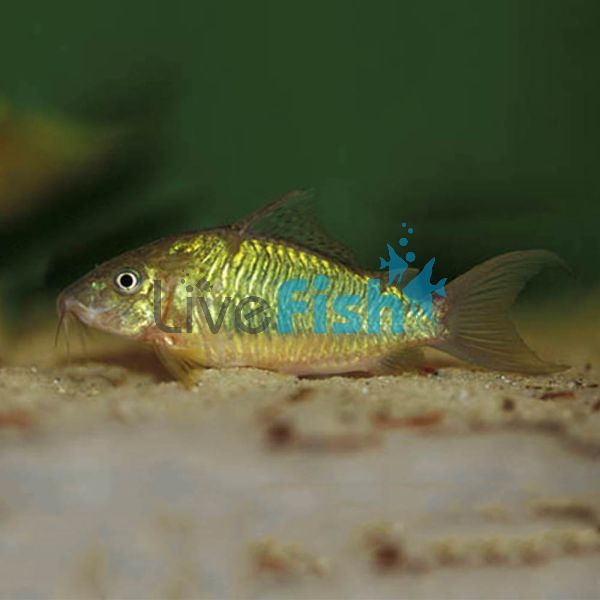Emerald Catfish 5cm
For a fish that looks nearly identical to a corydoras, surprisingly the emerald catfish was not in the corydoras family at all for a long time. Aside from the mix-up of grouping in the catfish family tree, the emerald catfish has pretty much the same care requirements as any other common corydoras with the only difference being the size that these emerald catfish grow to. Reaching around 9 cm, these are like big green hulk corydora which is a fantastic option to add some noticeable life to the bottom of an aquarium.
Emerald Catfish
For a fish that looks nearly identical to a corydoras, surprisingly the emerald catfish was not in the corydoras family at all for a long time. Aside from the mix-up of grouping in the catfish family tree, the emerald catfish has pretty much the same care requirements as any other common corydoras with the only difference being the size that these emerald catfish grow to. Reaching around 9 cm, these are like big green hulk corydora which is a fantastic option to add some noticeable life to the bottom of an aquarium.
Emerald catfish as their name suggests have a beautiful emerald green colour from head to tail with an equally stunning gold belly. They have a real metallic sheen that captures the aquarium light amazingly well which makes these fish so noticeable along with their size. Their larger size makes them a species to add with semi-aggressive tank mates as they are usually left alone. Their active bottom-dwelling behavior also makes this species a great dither fish option with shy tank mates.
Just like a corydoras species the emerald catfish constantly stir the substrate layer in order to look for food. This behavior ensures they are keeping the substrate turned over and any debris in the water column, which can then be picked up by the aquarium filter. The larger size of the emerald catfish makes them particularly effective at this behavior which makes them a great alternative to the more basic corydoras options. Emerald catfish are not shy fish either like plecos and are constantly active, making them great and popular fish for the community and planted aquariums. These fish are also considered to be schooling catfish, in the wild they are often seen in groups of a few hundred however in the home aquarium it is recommended to keep at least 3 or more. An ideal school would be around 6 plus individuals to really make them feel comfortable and to add some activity to the tank.
Differentiating males and females are possible where the males are often smaller and narrower compared to the larger-bodied females. The best method to identify is to get a pack of 4-6 emerald catfish and let a pair naturally form. Females are often triggered to spawn after being fed high-quality food and a slight reduction in the temperature through ideally a cold-water change. The wild origin of the emerald catfish in South America.
Tank Recommendations for your Emerald Catfish
As emerald catfish reach around 9 cm as adults it is best to keep them in an aquarium with a minimum volume of around 70 liters plus. A larger aquarium will always be better due to their active behavior and it also allows for the space to keep other tank mates. A sand substrate is best as coarser substrates like gravel often result in catfish damaging their barbels. Emerald catfish will love large, open sand beds however plants and hardscapes can certainly be included with no issues. This will give the catfish places of refuge and make them feel more comfortable.
Suitable Tank Buddies
Emerald Catfish is an incredibly peaceful fish that can be kept in an absolutely massive range of community aquariums. They do not display any aggression even when breeding and make for a perfect addition even with sensitive or shy fish. The only factor which should be considered is that these catfish are almost exclusively a bottom-dwelling species which means that any super active or large top-dwelling fish may outcompete the corydoras for food.
Usually Compatible
community fish such as rams, tetras, angelfish, discus, rainbow fish, and many more.
Sometimes Compatible
Fire mouth cichlids, Blue Acara, Jack Dempsey cichlids, and other large and semi-aggressive cichlids may pester the catfish.
Rarely Compatible
Large-mouthed and aggressive species such as saratoga or saratoga may prey on the catfish. This is especially important as emerald catfish have spines on their pectoral fins which can get lodged in the predator's throat. This can result in both the corydoras and the predator fish’s death.
Feeding your Emerald Catfish
Just like any other bottom-dwelling catfish, these emerald catfish should be fed a range of sinking pellets and frozen foods. The ideal diet would be a good quality micro slow-sinking pellet or crushed flake, supplemented with frozen bloodworms or black worms or even live foods like baby brine shrimp or micro worms.
| Scientific Name | Brochis splendens |
|---|---|
| Care Level | Easy |
| Common Names | Emerald Catfish, Emerald Brochis, Emerald Corydoras, Brochis Corydora |
| Diet | Carnivore |
| Fish Family | Callichthyidae |
| Lifespan (years) | 5 |
| Max. Length (cm) | 9 |
| Min. Tank Volume (l) | 70 Liters |
| Origin | South America |
| Reef Safe | Yes |
| Sociability | Peaceful |
| Venomous | No |
| Water Conditions | 24-26° C, pH 6.0-7.0 |




